Elementary Statistics: Data Analysis, Probability, and Interpretation
VerifiedAdded on 2023/01/13
|16
|1958
|32
Homework Assignment
AI Summary
This document provides a detailed solution to an elementary statistics assignment. The assignment covers various statistical concepts, including frequency distribution, mean, mode, median, and standard deviation calculations. It explores data analysis through tables and charts, such as frequency ch...

ELEMENTARY STATISTICS
Paraphrase This Document
Need a fresh take? Get an instant paraphrase of this document with our AI Paraphraser
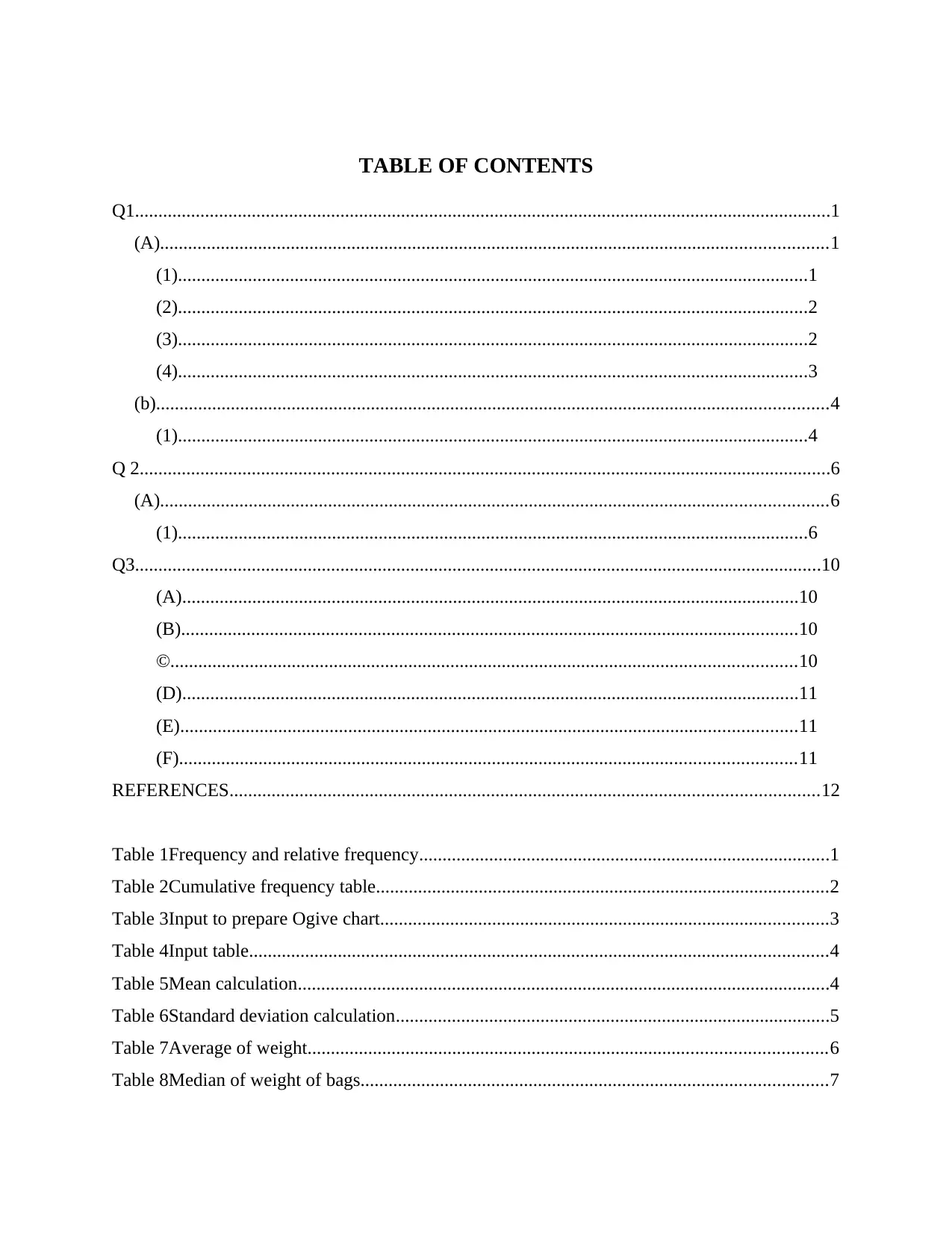
TABLE OF CONTENTS
Q1.....................................................................................................................................................1
(A)...............................................................................................................................................1
(1).......................................................................................................................................1
(2).......................................................................................................................................2
(3).......................................................................................................................................2
(4).......................................................................................................................................3
(b)................................................................................................................................................4
(1).......................................................................................................................................4
Q 2....................................................................................................................................................6
(A)...............................................................................................................................................6
(1).......................................................................................................................................6
Q3...................................................................................................................................................10
(A)....................................................................................................................................10
(B)....................................................................................................................................10
©......................................................................................................................................10
(D)....................................................................................................................................11
(E)....................................................................................................................................11
(F)....................................................................................................................................11
REFERENCES..............................................................................................................................12
Table 1Frequency and relative frequency........................................................................................1
Table 2Cumulative frequency table.................................................................................................2
Table 3Input to prepare Ogive chart................................................................................................3
Table 4Input table............................................................................................................................4
Table 5Mean calculation..................................................................................................................4
Table 6Standard deviation calculation.............................................................................................5
Table 7Average of weight...............................................................................................................6
Table 8Median of weight of bags....................................................................................................7
Q1.....................................................................................................................................................1
(A)...............................................................................................................................................1
(1).......................................................................................................................................1
(2).......................................................................................................................................2
(3).......................................................................................................................................2
(4).......................................................................................................................................3
(b)................................................................................................................................................4
(1).......................................................................................................................................4
Q 2....................................................................................................................................................6
(A)...............................................................................................................................................6
(1).......................................................................................................................................6
Q3...................................................................................................................................................10
(A)....................................................................................................................................10
(B)....................................................................................................................................10
©......................................................................................................................................10
(D)....................................................................................................................................11
(E)....................................................................................................................................11
(F)....................................................................................................................................11
REFERENCES..............................................................................................................................12
Table 1Frequency and relative frequency........................................................................................1
Table 2Cumulative frequency table.................................................................................................2
Table 3Input to prepare Ogive chart................................................................................................3
Table 4Input table............................................................................................................................4
Table 5Mean calculation..................................................................................................................4
Table 6Standard deviation calculation.............................................................................................5
Table 7Average of weight...............................................................................................................6
Table 8Median of weight of bags....................................................................................................7
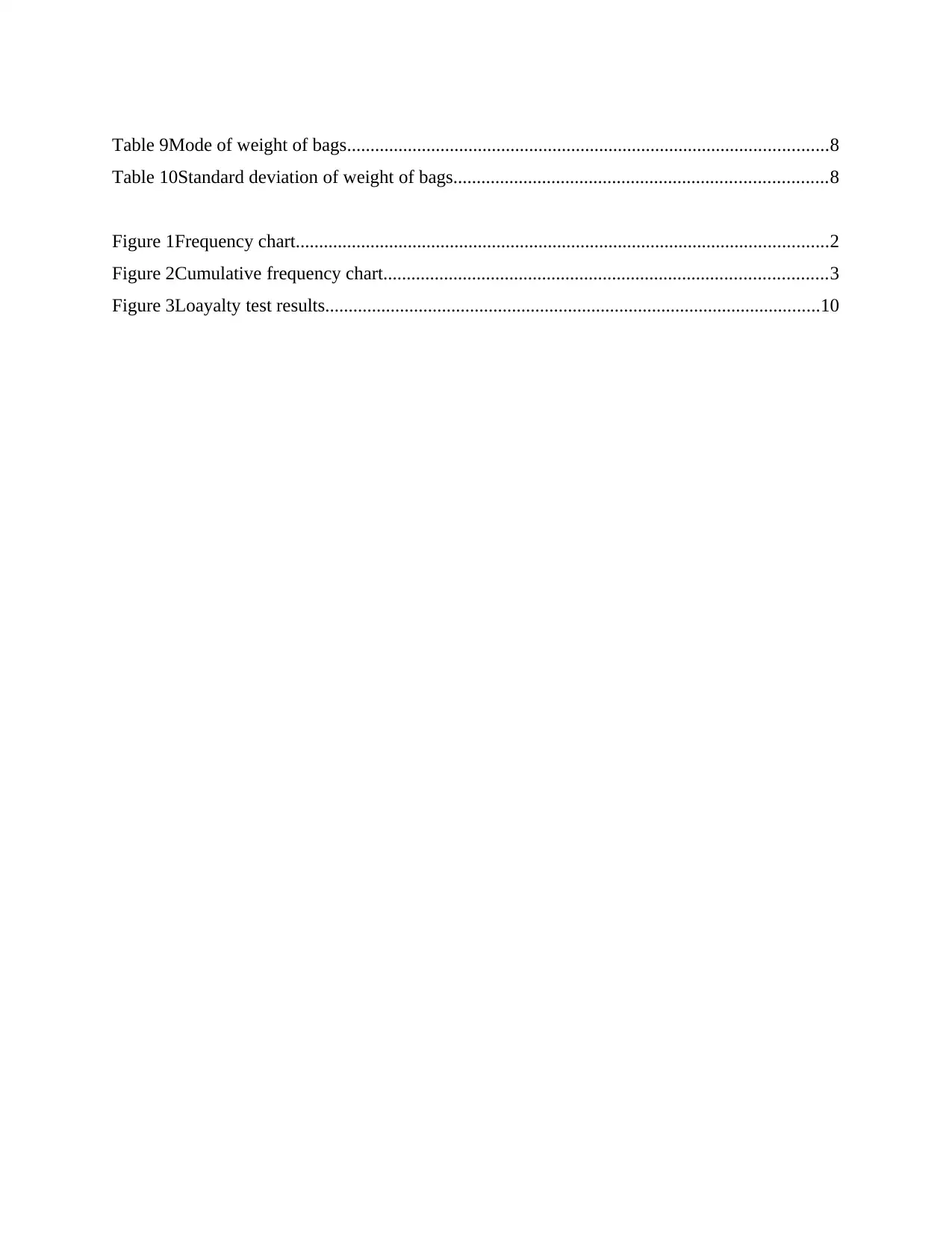
Table 9Mode of weight of bags.......................................................................................................8
Table 10Standard deviation of weight of bags................................................................................8
Figure 1Frequency chart..................................................................................................................2
Figure 2Cumulative frequency chart...............................................................................................3
Figure 3Loayalty test results..........................................................................................................10
Table 10Standard deviation of weight of bags................................................................................8
Figure 1Frequency chart..................................................................................................................2
Figure 2Cumulative frequency chart...............................................................................................3
Figure 3Loayalty test results..........................................................................................................10
⊘ This is a preview!⊘
Do you want full access?
Subscribe today to unlock all pages.

Trusted by 1+ million students worldwide
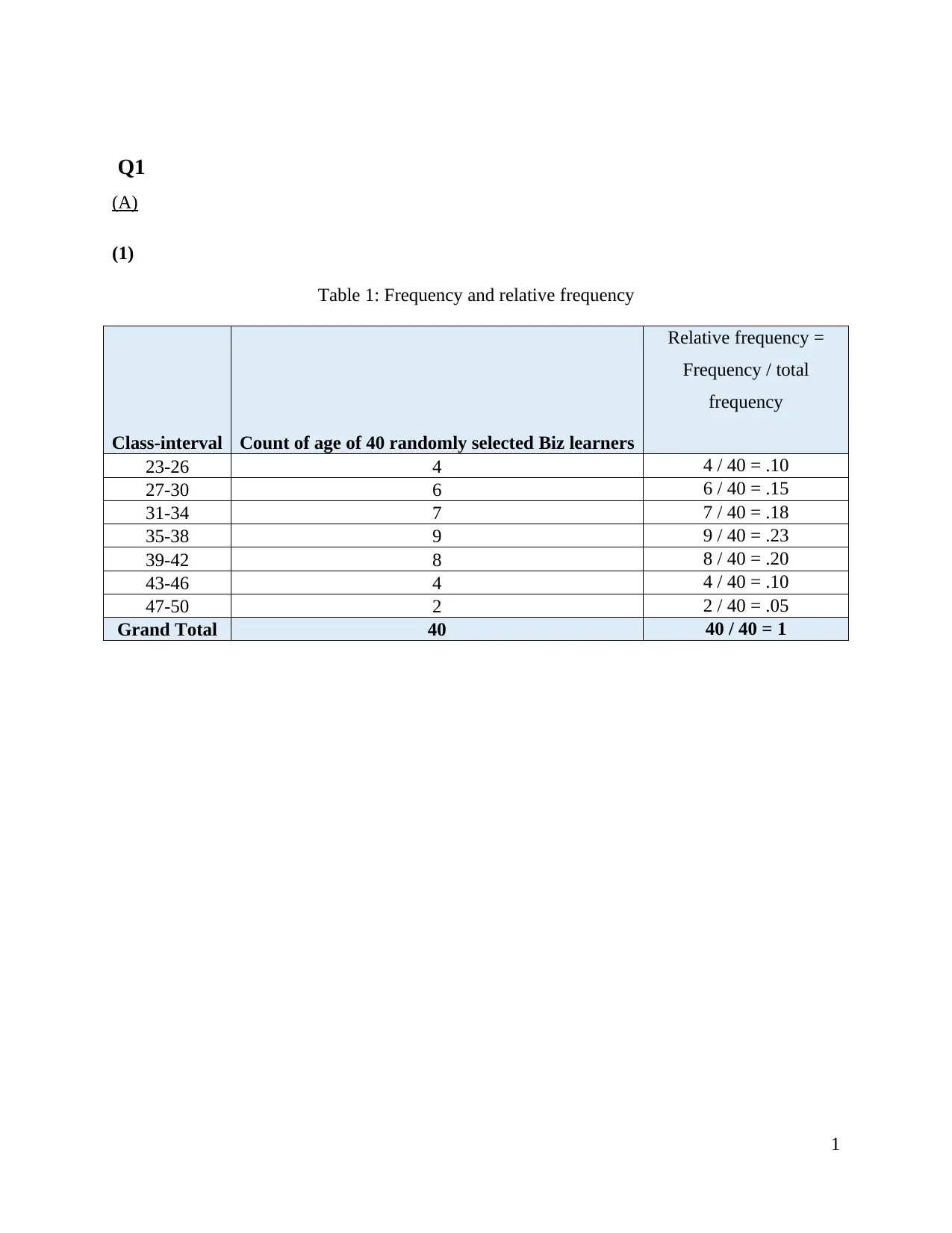
Q1
(A)
(1)
Table 1: Frequency and relative frequency
Class-interval Count of age of 40 randomly selected Biz learners
Relative frequency =
Frequency / total
frequency
23-26 4 4 / 40 = .10
27-30 6 6 / 40 = .15
31-34 7 7 / 40 = .18
35-38 9 9 / 40 = .23
39-42 8 8 / 40 = .20
43-46 4 4 / 40 = .10
47-50 2 2 / 40 = .05
Grand Total 40 40 / 40 = 1
1
(A)
(1)
Table 1: Frequency and relative frequency
Class-interval Count of age of 40 randomly selected Biz learners
Relative frequency =
Frequency / total
frequency
23-26 4 4 / 40 = .10
27-30 6 6 / 40 = .15
31-34 7 7 / 40 = .18
35-38 9 9 / 40 = .23
39-42 8 8 / 40 = .20
43-46 4 4 / 40 = .10
47-50 2 2 / 40 = .05
Grand Total 40 40 / 40 = 1
1
Paraphrase This Document
Need a fresh take? Get an instant paraphrase of this document with our AI Paraphraser
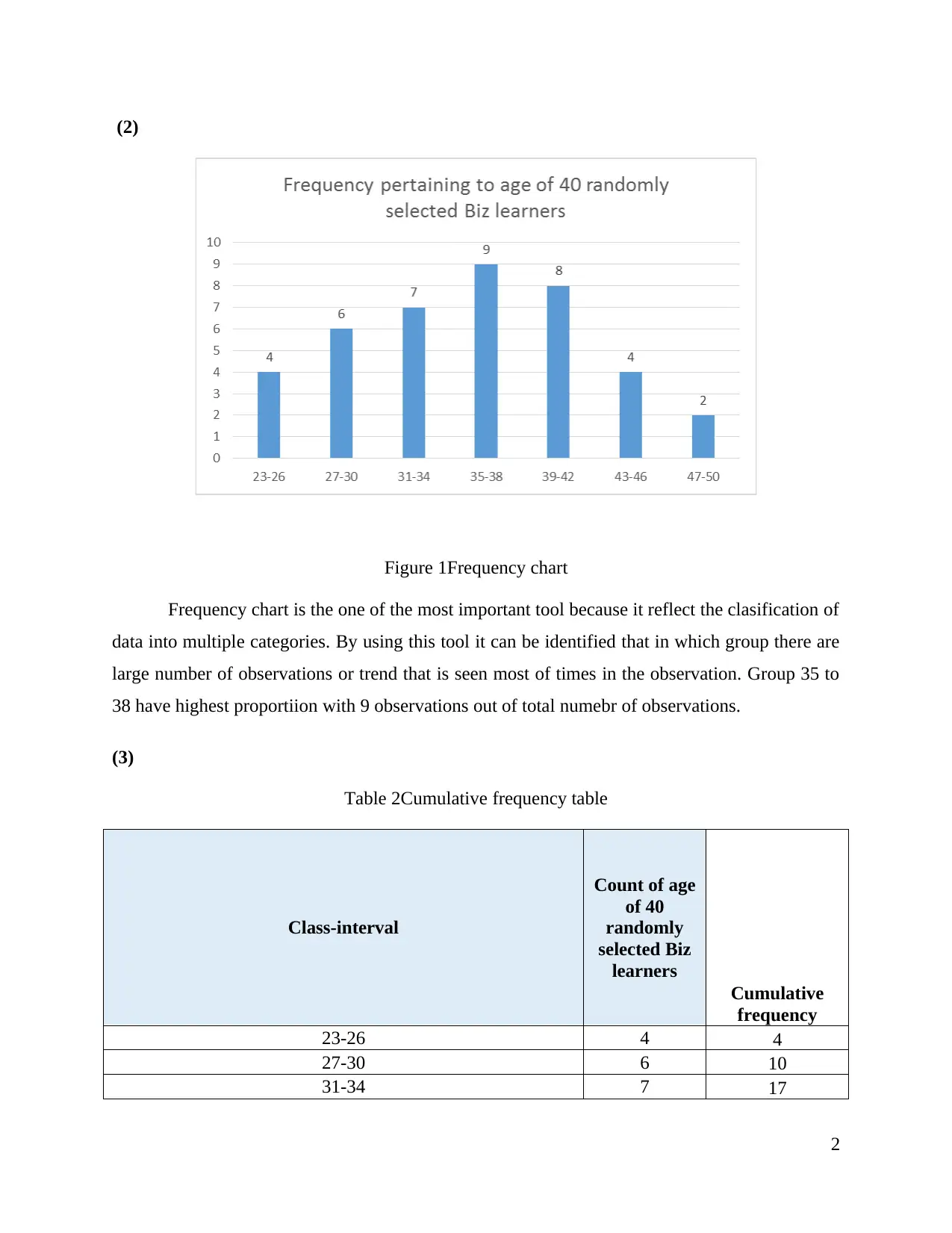
(2)
Figure 1Frequency chart
Frequency chart is the one of the most important tool because it reflect the clasification of
data into multiple categories. By using this tool it can be identified that in which group there are
large number of observations or trend that is seen most of times in the observation. Group 35 to
38 have highest proportiion with 9 observations out of total numebr of observations.
(3)
Table 2Cumulative frequency table
Class-interval
Count of age
of 40
randomly
selected Biz
learners
Cumulative
frequency
23-26 4 4
27-30 6 10
31-34 7 17
2
Figure 1Frequency chart
Frequency chart is the one of the most important tool because it reflect the clasification of
data into multiple categories. By using this tool it can be identified that in which group there are
large number of observations or trend that is seen most of times in the observation. Group 35 to
38 have highest proportiion with 9 observations out of total numebr of observations.
(3)
Table 2Cumulative frequency table
Class-interval
Count of age
of 40
randomly
selected Biz
learners
Cumulative
frequency
23-26 4 4
27-30 6 10
31-34 7 17
2

35-38 9 26
39-42 8 34
43-46 4 38
47-50 2 40
Total 40
Figure 2Cumulative frequency chart
(4)
Particulars
Age of Biz
learners
Quartile 1 31
Quartile 2 (Median) 36
Quartile 3 39
On evaluation of Ogive chart given above it is identified that value of Q1 is 31, Q2 is 36
and Q3 is 39 respectively.
3
39-42 8 34
43-46 4 38
47-50 2 40
Total 40
Figure 2Cumulative frequency chart
(4)
Particulars
Age of Biz
learners
Quartile 1 31
Quartile 2 (Median) 36
Quartile 3 39
On evaluation of Ogive chart given above it is identified that value of Q1 is 31, Q2 is 36
and Q3 is 39 respectively.
3
⊘ This is a preview!⊘
Do you want full access?
Subscribe today to unlock all pages.

Trusted by 1+ million students worldwide
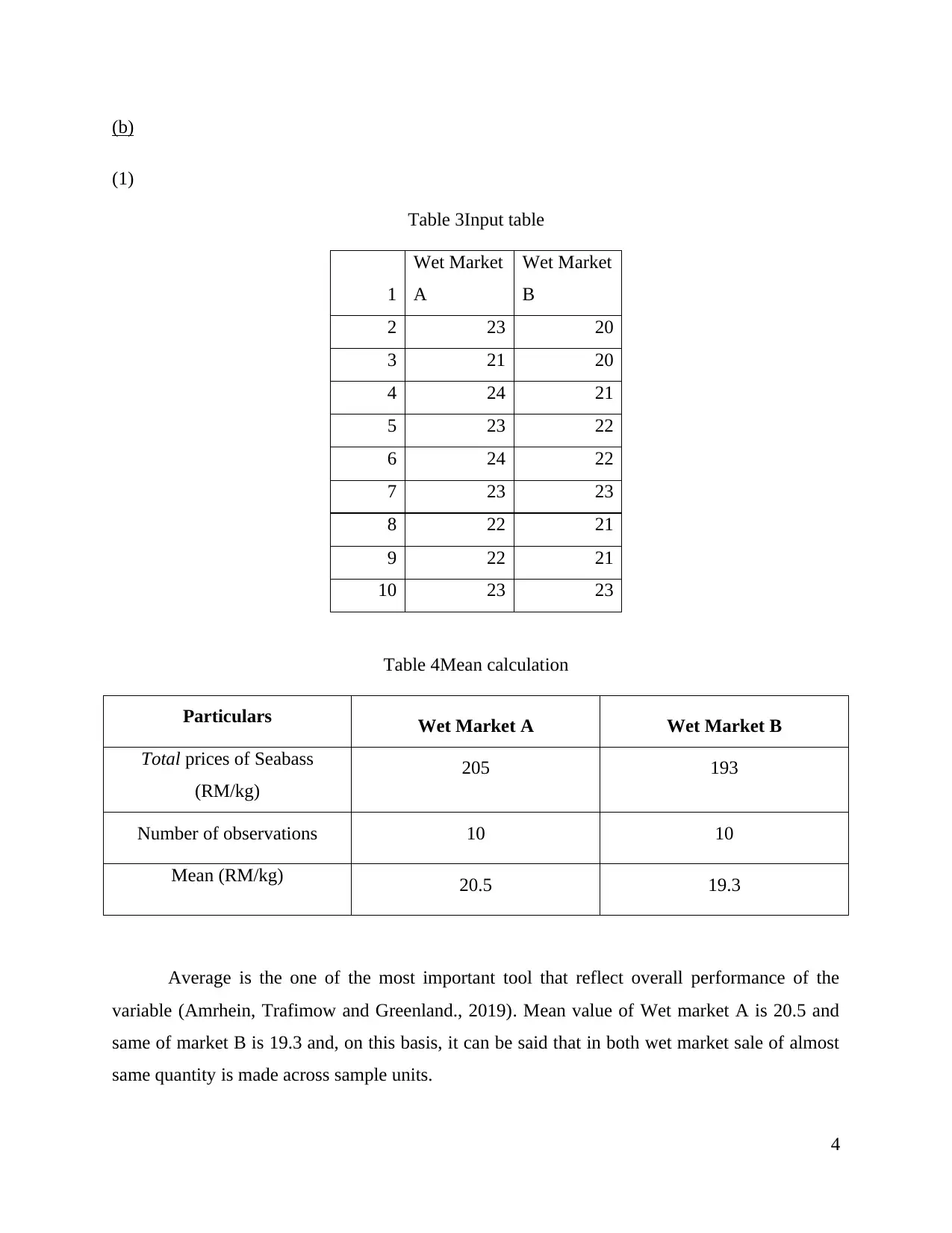
(b)
(1)
Table 3Input table
1
Wet Market
A
Wet Market
B
2 23 20
3 21 20
4 24 21
5 23 22
6 24 22
7 23 23
8 22 21
9 22 21
10 23 23
Table 4Mean calculation
Particulars Wet Market A Wet Market B
Total prices of Seabass
(RM/kg)
205 193
Number of observations 10 10
Mean (RM/kg) 20.5 19.3
Average is the one of the most important tool that reflect overall performance of the
variable (Amrhein, Trafimow and Greenland., 2019). Mean value of Wet market A is 20.5 and
same of market B is 19.3 and, on this basis, it can be said that in both wet market sale of almost
same quantity is made across sample units.
4
(1)
Table 3Input table
1
Wet Market
A
Wet Market
B
2 23 20
3 21 20
4 24 21
5 23 22
6 24 22
7 23 23
8 22 21
9 22 21
10 23 23
Table 4Mean calculation
Particulars Wet Market A Wet Market B
Total prices of Seabass
(RM/kg)
205 193
Number of observations 10 10
Mean (RM/kg) 20.5 19.3
Average is the one of the most important tool that reflect overall performance of the
variable (Amrhein, Trafimow and Greenland., 2019). Mean value of Wet market A is 20.5 and
same of market B is 19.3 and, on this basis, it can be said that in both wet market sale of almost
same quantity is made across sample units.
4
Paraphrase This Document
Need a fresh take? Get an instant paraphrase of this document with our AI Paraphraser

Table 5: Standard deviation calculation
1 Wet
Market A X – Mean (X – Mean)^2
2 23 2.5 6.25
3 21 0.5 0.25
4 24 3.5 12.25
5 23 2.5 6.25
6 24 3.5 12.25
7 23 2.5 6.25
8 22 1.5 2.25
9 22 1.5 2.25
10 23 2.5 6.25
205 20.5 54.25
Variance = 54.25 / 10
= 5.425
Standard deviation = SQRT(Variance)
=√5.425
= 2.33
1 Wet
Market b X – Mean (X – Mean)^2
2 20 0.7 0.49
3 20 0.7 0.49
4 21 1.7 2.89
5 22 2.7 7.29
6 22 2.7 7.29
7 23 3.7 13.69
8 21 1.7 2.89
9 21 1.7 2.89
10 23 3.7 13.69
Total 193 19.3 51.61
Variance = 51.61 / 10
= 5.161
Standard deviation = SQRT(Variance)
=√5.161
5
1 Wet
Market A X – Mean (X – Mean)^2
2 23 2.5 6.25
3 21 0.5 0.25
4 24 3.5 12.25
5 23 2.5 6.25
6 24 3.5 12.25
7 23 2.5 6.25
8 22 1.5 2.25
9 22 1.5 2.25
10 23 2.5 6.25
205 20.5 54.25
Variance = 54.25 / 10
= 5.425
Standard deviation = SQRT(Variance)
=√5.425
= 2.33
1 Wet
Market b X – Mean (X – Mean)^2
2 20 0.7 0.49
3 20 0.7 0.49
4 21 1.7 2.89
5 22 2.7 7.29
6 22 2.7 7.29
7 23 3.7 13.69
8 21 1.7 2.89
9 21 1.7 2.89
10 23 3.7 13.69
Total 193 19.3 51.61
Variance = 51.61 / 10
= 5.161
Standard deviation = SQRT(Variance)
=√5.161
5
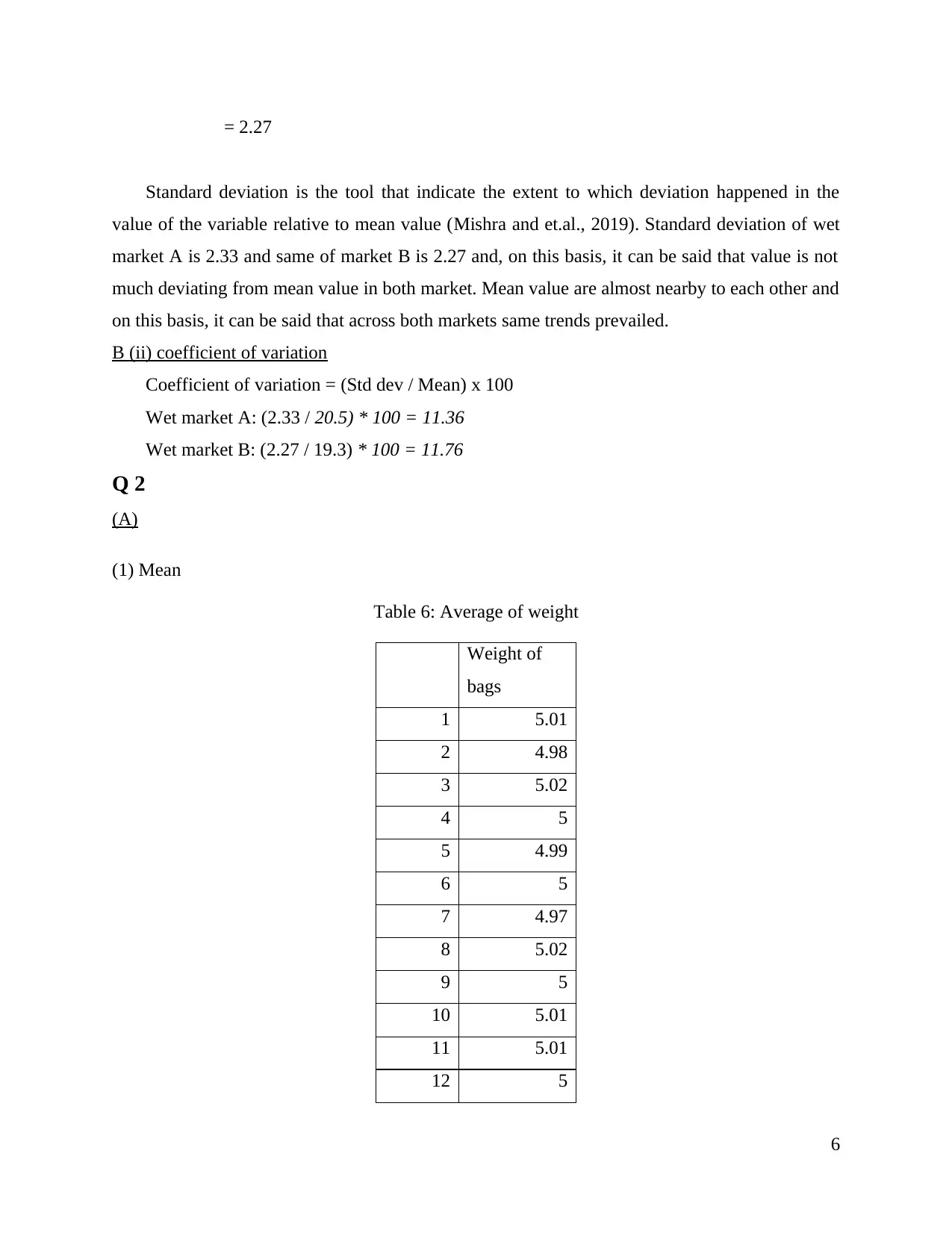
= 2.27
Standard deviation is the tool that indicate the extent to which deviation happened in the
value of the variable relative to mean value (Mishra and et.al., 2019). Standard deviation of wet
market A is 2.33 and same of market B is 2.27 and, on this basis, it can be said that value is not
much deviating from mean value in both market. Mean value are almost nearby to each other and
on this basis, it can be said that across both markets same trends prevailed.
B (ii) coefficient of variation
Coefficient of variation = (Std dev / Mean) x 100
Wet market A: (2.33 / 20.5) * 100 = 11.36
Wet market B: (2.27 / 19.3) * 100 = 11.76
Q 2
(A)
(1) Mean
Table 6: Average of weight
Weight of
bags
1 5.01
2 4.98
3 5.02
4 5
5 4.99
6 5
7 4.97
8 5.02
9 5
10 5.01
11 5.01
12 5
6
Standard deviation is the tool that indicate the extent to which deviation happened in the
value of the variable relative to mean value (Mishra and et.al., 2019). Standard deviation of wet
market A is 2.33 and same of market B is 2.27 and, on this basis, it can be said that value is not
much deviating from mean value in both market. Mean value are almost nearby to each other and
on this basis, it can be said that across both markets same trends prevailed.
B (ii) coefficient of variation
Coefficient of variation = (Std dev / Mean) x 100
Wet market A: (2.33 / 20.5) * 100 = 11.36
Wet market B: (2.27 / 19.3) * 100 = 11.76
Q 2
(A)
(1) Mean
Table 6: Average of weight
Weight of
bags
1 5.01
2 4.98
3 5.02
4 5
5 4.99
6 5
7 4.97
8 5.02
9 5
10 5.01
11 5.01
12 5
6
⊘ This is a preview!⊘
Do you want full access?
Subscribe today to unlock all pages.

Trusted by 1+ million students worldwide

Total 60.01
Number
N 12
Average 5.00
Mean = Sum of observations/ Number of observations
= 60.01/12 = 5 kg
Mean value of the variable is 5 which means that on an average basis weight of the rice
5KG in most of bags.
2. Mode
Table 8: Mode of weight of bags
Weight of bags Count of Weight of bags / frequency
4.97 1
4.98 1
4.99 1
5 4
5.01 3
5.02 2
Grand Total 12
Mode value is 5 because it repeated 4 times in the dataset which is high in the number.
3. Median
Table 9: Median of weight of bags
Weight
of bags
1 4.97
2 4.98
3 4.99
4 5
5 5
6 5
7 5
8 5.01
9 5.01
7
Number
N 12
Average 5.00
Mean = Sum of observations/ Number of observations
= 60.01/12 = 5 kg
Mean value of the variable is 5 which means that on an average basis weight of the rice
5KG in most of bags.
2. Mode
Table 8: Mode of weight of bags
Weight of bags Count of Weight of bags / frequency
4.97 1
4.98 1
4.99 1
5 4
5.01 3
5.02 2
Grand Total 12
Mode value is 5 because it repeated 4 times in the dataset which is high in the number.
3. Median
Table 9: Median of weight of bags
Weight
of bags
1 4.97
2 4.98
3 4.99
4 5
5 5
6 5
7 5
8 5.01
9 5.01
7
Paraphrase This Document
Need a fresh take? Get an instant paraphrase of this document with our AI Paraphraser
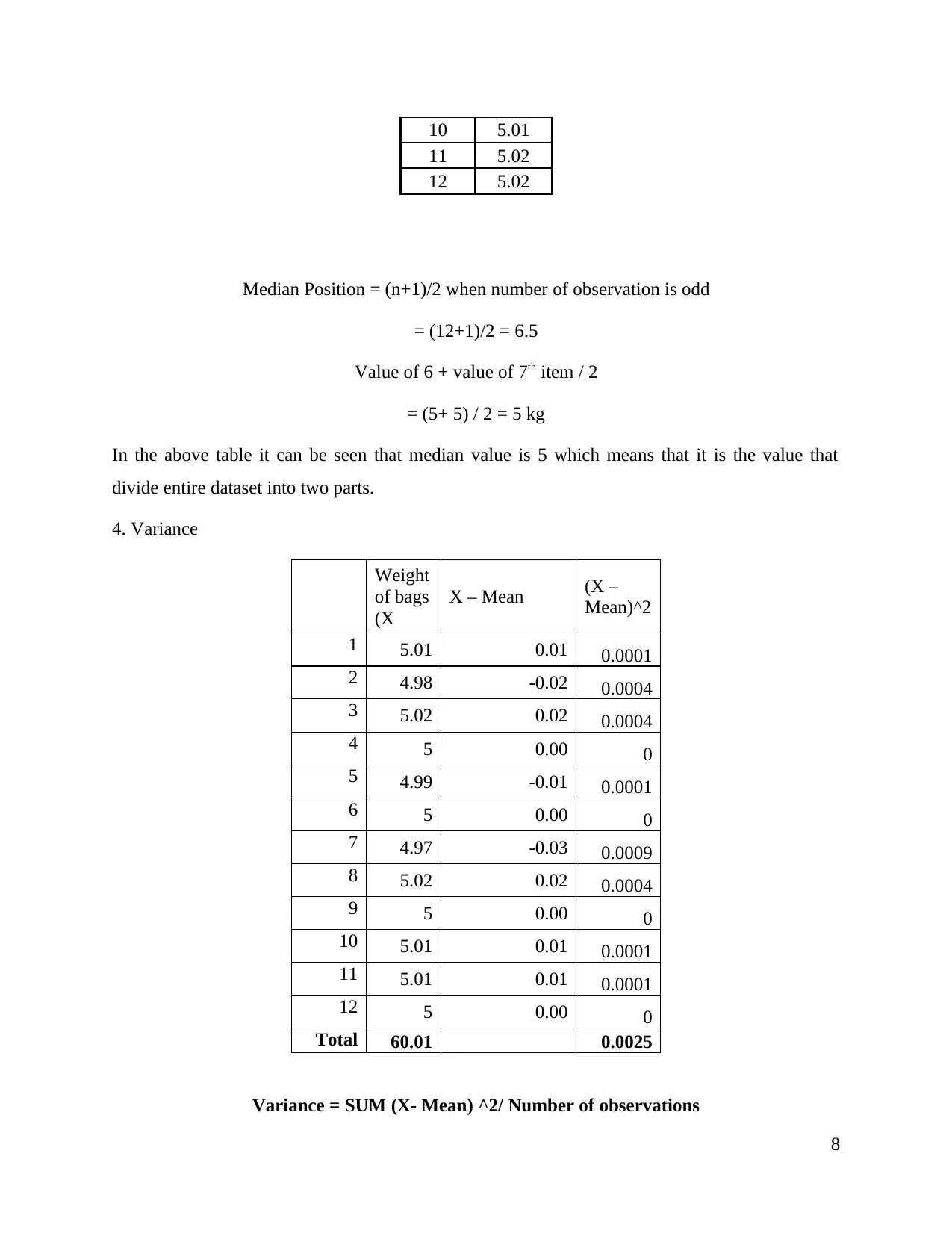
10 5.01
11 5.02
12 5.02
Median Position = (n+1)/2 when number of observation is odd
= (12+1)/2 = 6.5
Value of 6 + value of 7th item / 2
= (5+ 5) / 2 = 5 kg
In the above table it can be seen that median value is 5 which means that it is the value that
divide entire dataset into two parts.
4. Variance
Weight
of bags
(X
X – Mean (X –
Mean)^2
1 5.01 0.01 0.0001
2 4.98 -0.02 0.0004
3 5.02 0.02 0.0004
4 5 0.00 0
5 4.99 -0.01 0.0001
6 5 0.00 0
7 4.97 -0.03 0.0009
8 5.02 0.02 0.0004
9 5 0.00 0
10 5.01 0.01 0.0001
11 5.01 0.01 0.0001
12 5 0.00 0
Total 60.01 0.0025
Variance = SUM (X- Mean) ^2/ Number of observations
8
11 5.02
12 5.02
Median Position = (n+1)/2 when number of observation is odd
= (12+1)/2 = 6.5
Value of 6 + value of 7th item / 2
= (5+ 5) / 2 = 5 kg
In the above table it can be seen that median value is 5 which means that it is the value that
divide entire dataset into two parts.
4. Variance
Weight
of bags
(X
X – Mean (X –
Mean)^2
1 5.01 0.01 0.0001
2 4.98 -0.02 0.0004
3 5.02 0.02 0.0004
4 5 0.00 0
5 4.99 -0.01 0.0001
6 5 0.00 0
7 4.97 -0.03 0.0009
8 5.02 0.02 0.0004
9 5 0.00 0
10 5.01 0.01 0.0001
11 5.01 0.01 0.0001
12 5 0.00 0
Total 60.01 0.0025
Variance = SUM (X- Mean) ^2/ Number of observations
8
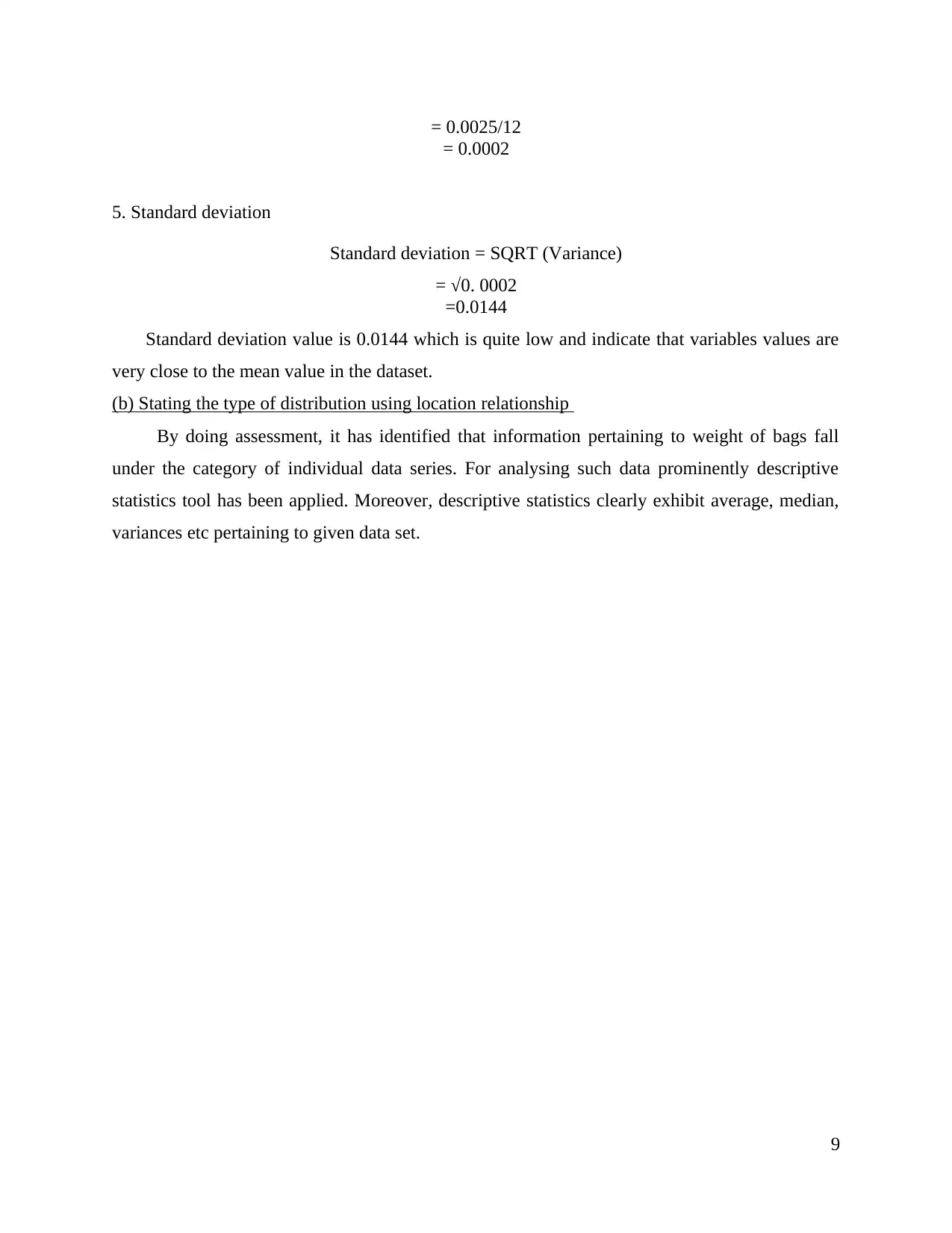
= 0.0025/12
= 0.0002
5. Standard deviation
Standard deviation = SQRT (Variance)
= √0. 0002
=0.0144
Standard deviation value is 0.0144 which is quite low and indicate that variables values are
very close to the mean value in the dataset.
(b) Stating the type of distribution using location relationship
By doing assessment, it has identified that information pertaining to weight of bags fall
under the category of individual data series. For analysing such data prominently descriptive
statistics tool has been applied. Moreover, descriptive statistics clearly exhibit average, median,
variances etc pertaining to given data set.
9
= 0.0002
5. Standard deviation
Standard deviation = SQRT (Variance)
= √0. 0002
=0.0144
Standard deviation value is 0.0144 which is quite low and indicate that variables values are
very close to the mean value in the dataset.
(b) Stating the type of distribution using location relationship
By doing assessment, it has identified that information pertaining to weight of bags fall
under the category of individual data series. For analysing such data prominently descriptive
statistics tool has been applied. Moreover, descriptive statistics clearly exhibit average, median,
variances etc pertaining to given data set.
9
⊘ This is a preview!⊘
Do you want full access?
Subscribe today to unlock all pages.

Trusted by 1+ million students worldwide
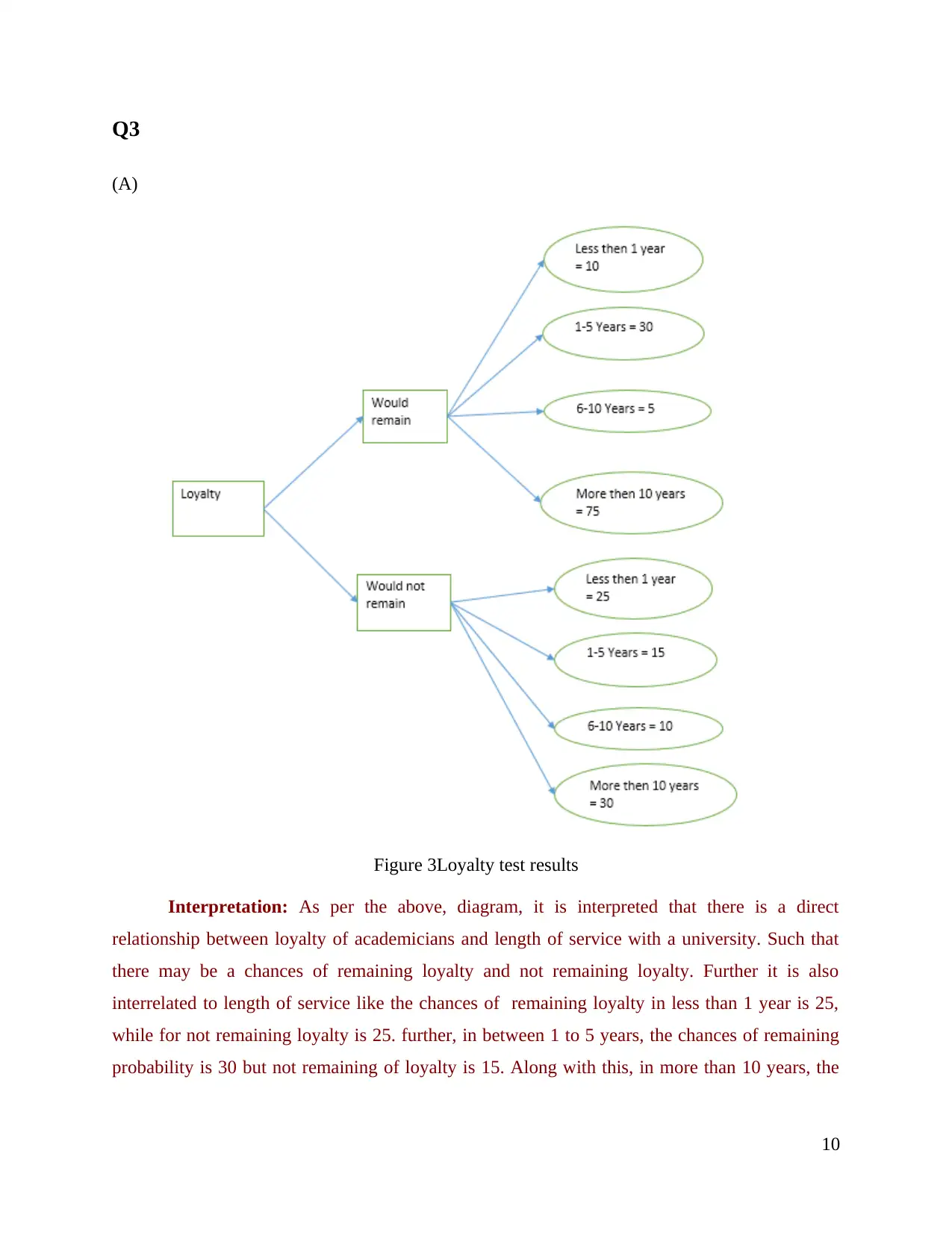
Q3
(A)
Figure 3Loyalty test results
Interpretation: As per the above, diagram, it is interpreted that there is a direct
relationship between loyalty of academicians and length of service with a university. Such that
there may be a chances of remaining loyalty and not remaining loyalty. Further it is also
interrelated to length of service like the chances of remaining loyalty in less than 1 year is 25,
while for not remaining loyalty is 25. further, in between 1 to 5 years, the chances of remaining
probability is 30 but not remaining of loyalty is 15. Along with this, in more than 10 years, the
10
(A)
Figure 3Loyalty test results
Interpretation: As per the above, diagram, it is interpreted that there is a direct
relationship between loyalty of academicians and length of service with a university. Such that
there may be a chances of remaining loyalty and not remaining loyalty. Further it is also
interrelated to length of service like the chances of remaining loyalty in less than 1 year is 25,
while for not remaining loyalty is 25. further, in between 1 to 5 years, the chances of remaining
probability is 30 but not remaining of loyalty is 15. Along with this, in more than 10 years, the
10
Paraphrase This Document
Need a fresh take? Get an instant paraphrase of this document with our AI Paraphraser
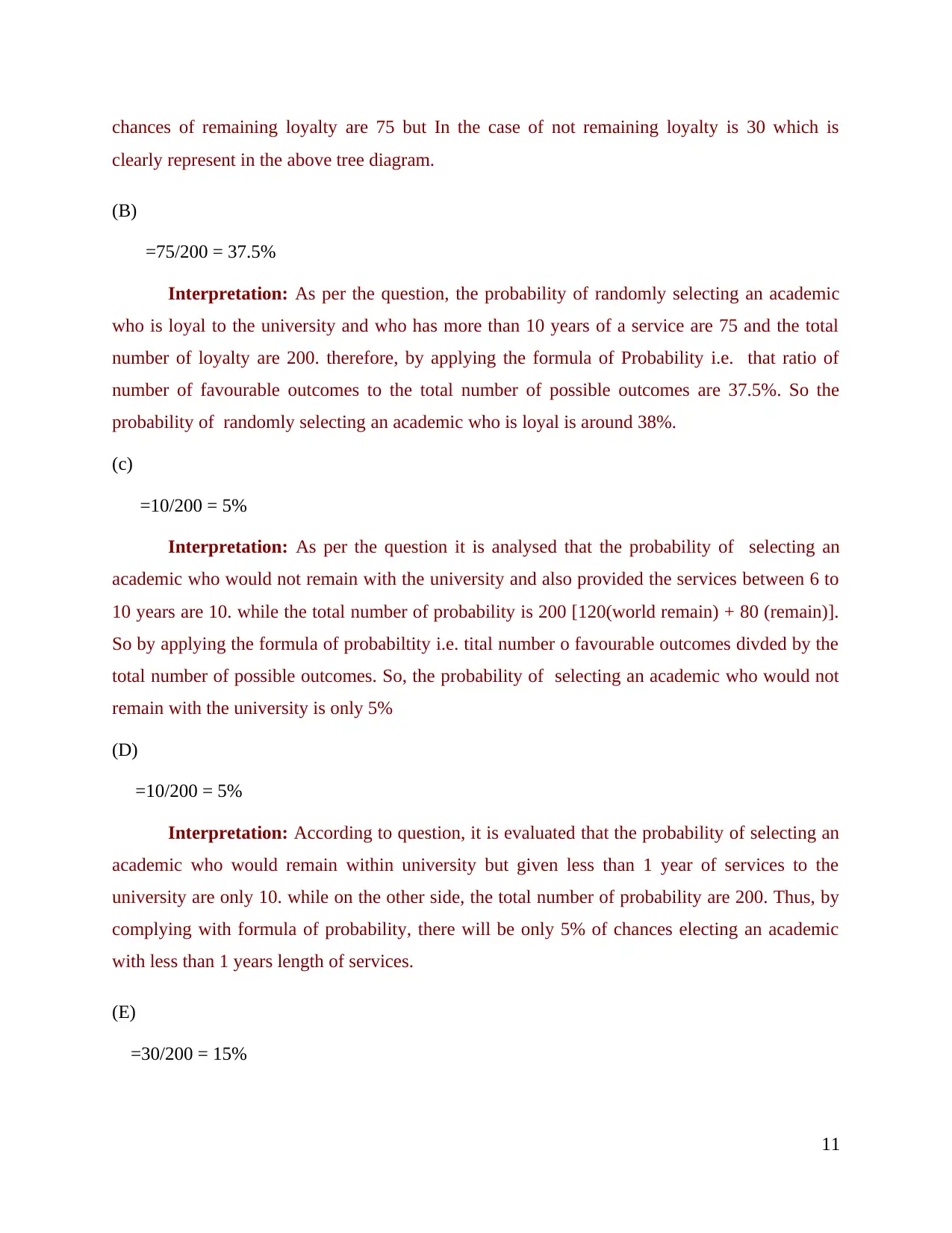
chances of remaining loyalty are 75 but In the case of not remaining loyalty is 30 which is
clearly represent in the above tree diagram.
(B)
=75/200 = 37.5%
Interpretation: As per the question, the probability of randomly selecting an academic
who is loyal to the university and who has more than 10 years of a service are 75 and the total
number of loyalty are 200. therefore, by applying the formula of Probability i.e. that ratio of
number of favourable outcomes to the total number of possible outcomes are 37.5%. So the
probability of randomly selecting an academic who is loyal is around 38%.
(c)
=10/200 = 5%
Interpretation: As per the question it is analysed that the probability of selecting an
academic who would not remain with the university and also provided the services between 6 to
10 years are 10. while the total number of probability is 200 [120(world remain) + 80 (remain)].
So by applying the formula of probabiltity i.e. tital number o favourable outcomes divded by the
total number of possible outcomes. So, the probability of selecting an academic who would not
remain with the university is only 5%
(D)
=10/200 = 5%
Interpretation: According to question, it is evaluated that the probability of selecting an
academic who would remain within university but given less than 1 year of services to the
university are only 10. while on the other side, the total number of probability are 200. Thus, by
complying with formula of probability, there will be only 5% of chances electing an academic
with less than 1 years length of services.
(E)
=30/200 = 15%
11
clearly represent in the above tree diagram.
(B)
=75/200 = 37.5%
Interpretation: As per the question, the probability of randomly selecting an academic
who is loyal to the university and who has more than 10 years of a service are 75 and the total
number of loyalty are 200. therefore, by applying the formula of Probability i.e. that ratio of
number of favourable outcomes to the total number of possible outcomes are 37.5%. So the
probability of randomly selecting an academic who is loyal is around 38%.
(c)
=10/200 = 5%
Interpretation: As per the question it is analysed that the probability of selecting an
academic who would not remain with the university and also provided the services between 6 to
10 years are 10. while the total number of probability is 200 [120(world remain) + 80 (remain)].
So by applying the formula of probabiltity i.e. tital number o favourable outcomes divded by the
total number of possible outcomes. So, the probability of selecting an academic who would not
remain with the university is only 5%
(D)
=10/200 = 5%
Interpretation: According to question, it is evaluated that the probability of selecting an
academic who would remain within university but given less than 1 year of services to the
university are only 10. while on the other side, the total number of probability are 200. Thus, by
complying with formula of probability, there will be only 5% of chances electing an academic
with less than 1 years length of services.
(E)
=30/200 = 15%
11
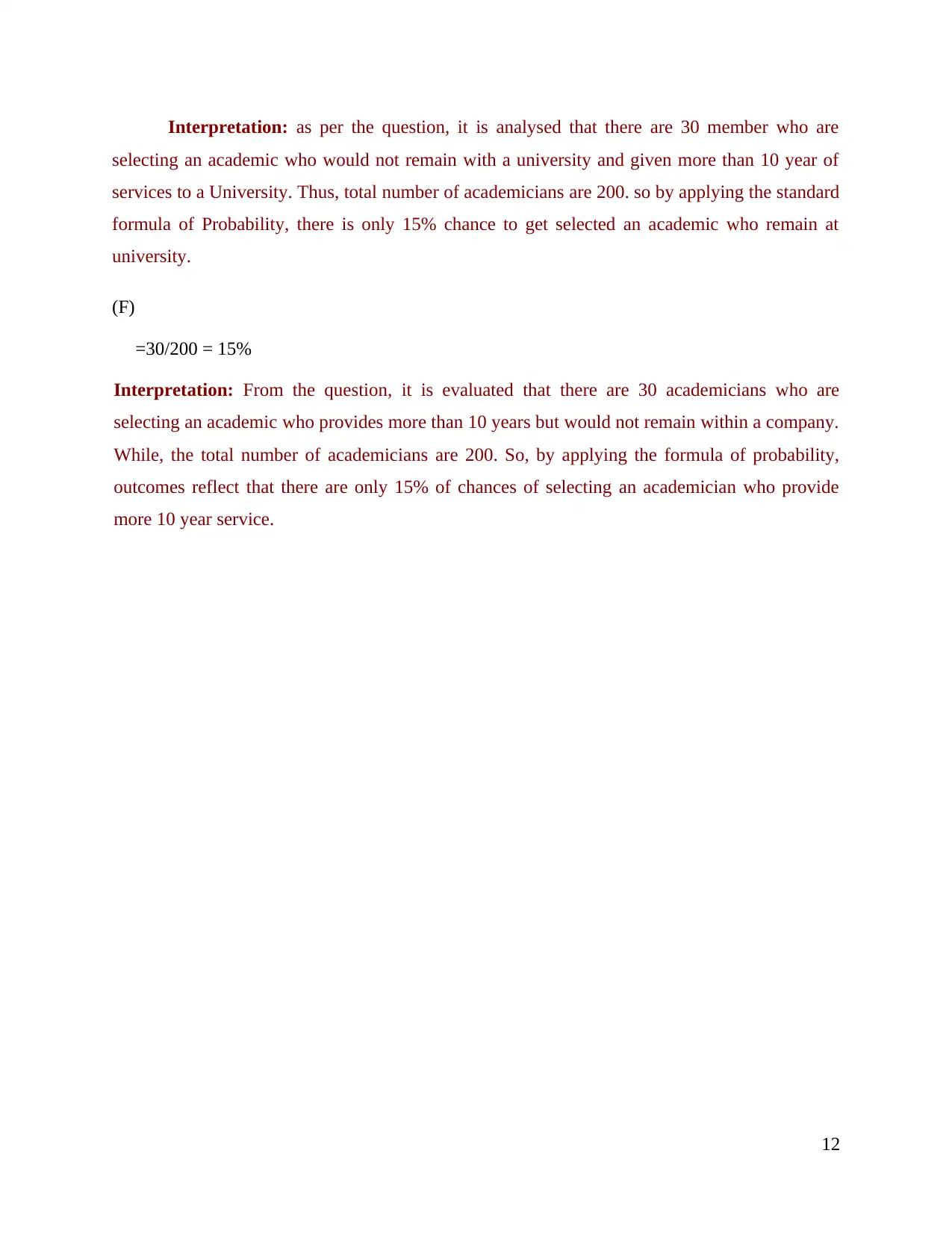
Interpretation: as per the question, it is analysed that there are 30 member who are
selecting an academic who would not remain with a university and given more than 10 year of
services to a University. Thus, total number of academicians are 200. so by applying the standard
formula of Probability, there is only 15% chance to get selected an academic who remain at
university.
(F)
=30/200 = 15%
Interpretation: From the question, it is evaluated that there are 30 academicians who are
selecting an academic who provides more than 10 years but would not remain within a company.
While, the total number of academicians are 200. So, by applying the formula of probability,
outcomes reflect that there are only 15% of chances of selecting an academician who provide
more 10 year service.
12
selecting an academic who would not remain with a university and given more than 10 year of
services to a University. Thus, total number of academicians are 200. so by applying the standard
formula of Probability, there is only 15% chance to get selected an academic who remain at
university.
(F)
=30/200 = 15%
Interpretation: From the question, it is evaluated that there are 30 academicians who are
selecting an academic who provides more than 10 years but would not remain within a company.
While, the total number of academicians are 200. So, by applying the formula of probability,
outcomes reflect that there are only 15% of chances of selecting an academician who provide
more 10 year service.
12
⊘ This is a preview!⊘
Do you want full access?
Subscribe today to unlock all pages.

Trusted by 1+ million students worldwide
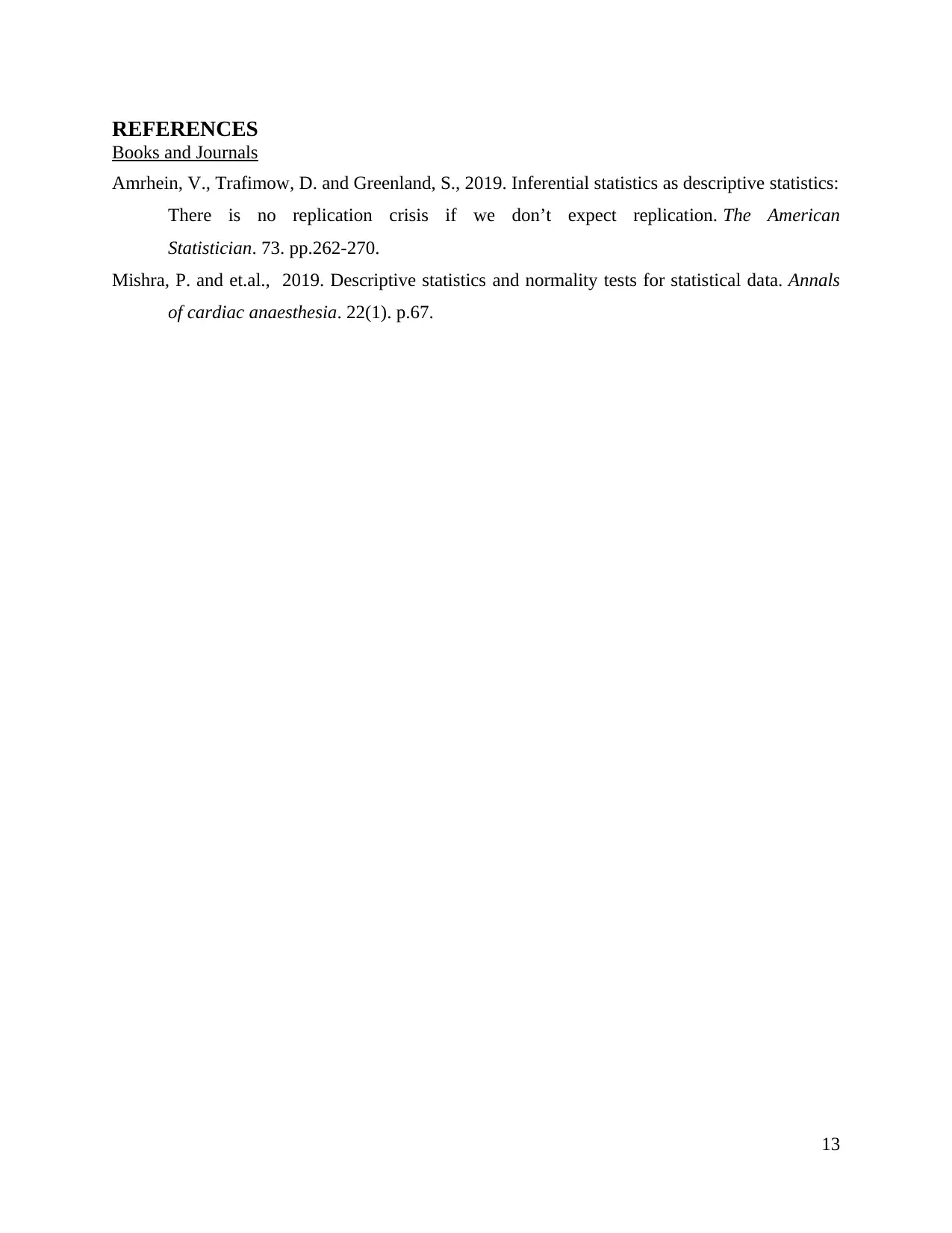
REFERENCES
Books and Journals
Amrhein, V., Trafimow, D. and Greenland, S., 2019. Inferential statistics as descriptive statistics:
There is no replication crisis if we don’t expect replication. The American
Statistician. 73. pp.262-270.
Mishra, P. and et.al., 2019. Descriptive statistics and normality tests for statistical data. Annals
of cardiac anaesthesia. 22(1). p.67.
13
Books and Journals
Amrhein, V., Trafimow, D. and Greenland, S., 2019. Inferential statistics as descriptive statistics:
There is no replication crisis if we don’t expect replication. The American
Statistician. 73. pp.262-270.
Mishra, P. and et.al., 2019. Descriptive statistics and normality tests for statistical data. Annals
of cardiac anaesthesia. 22(1). p.67.
13
1 out of 16
Related Documents
Your All-in-One AI-Powered Toolkit for Academic Success.
+13062052269
info@desklib.com
Available 24*7 on WhatsApp / Email
![[object Object]](/_next/static/media/star-bottom.7253800d.svg)
Unlock your academic potential
© 2024 | Zucol Services PVT LTD | All rights reserved.





